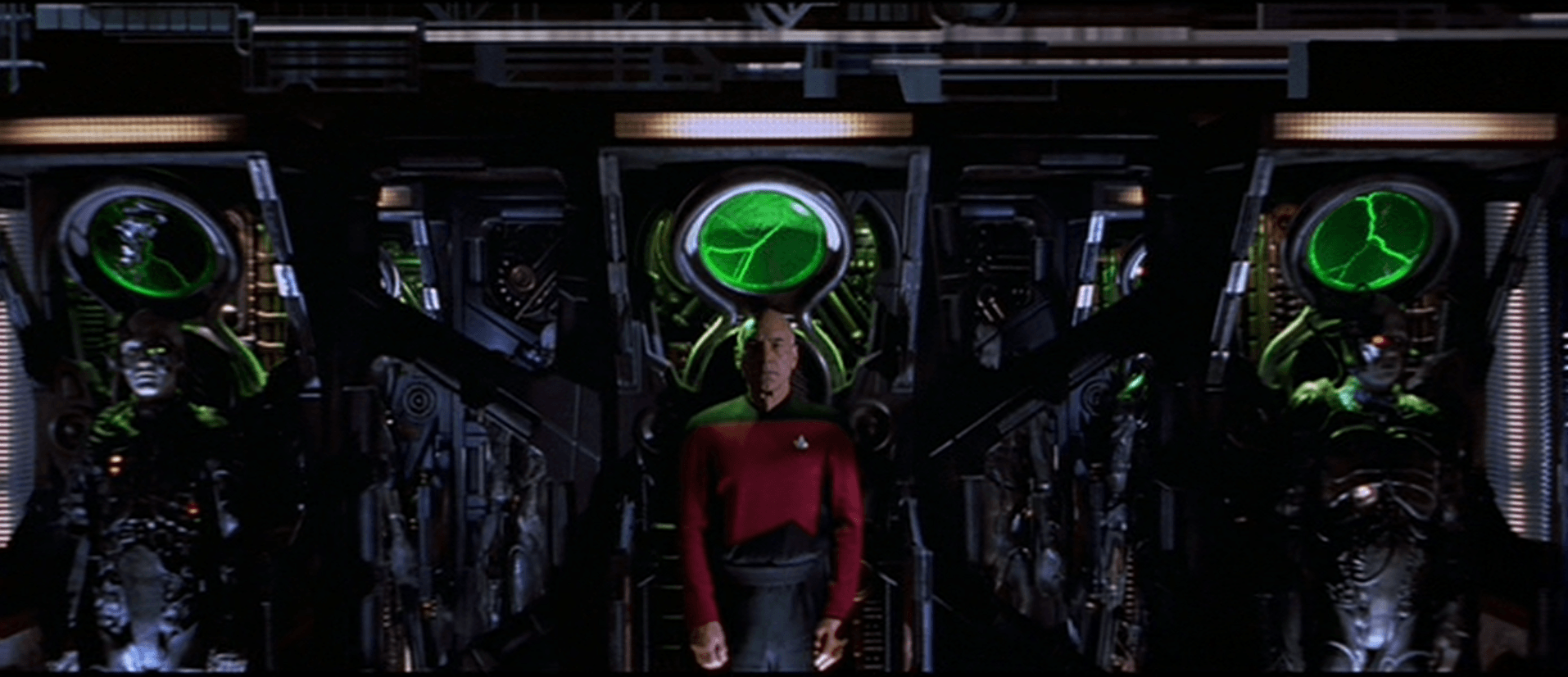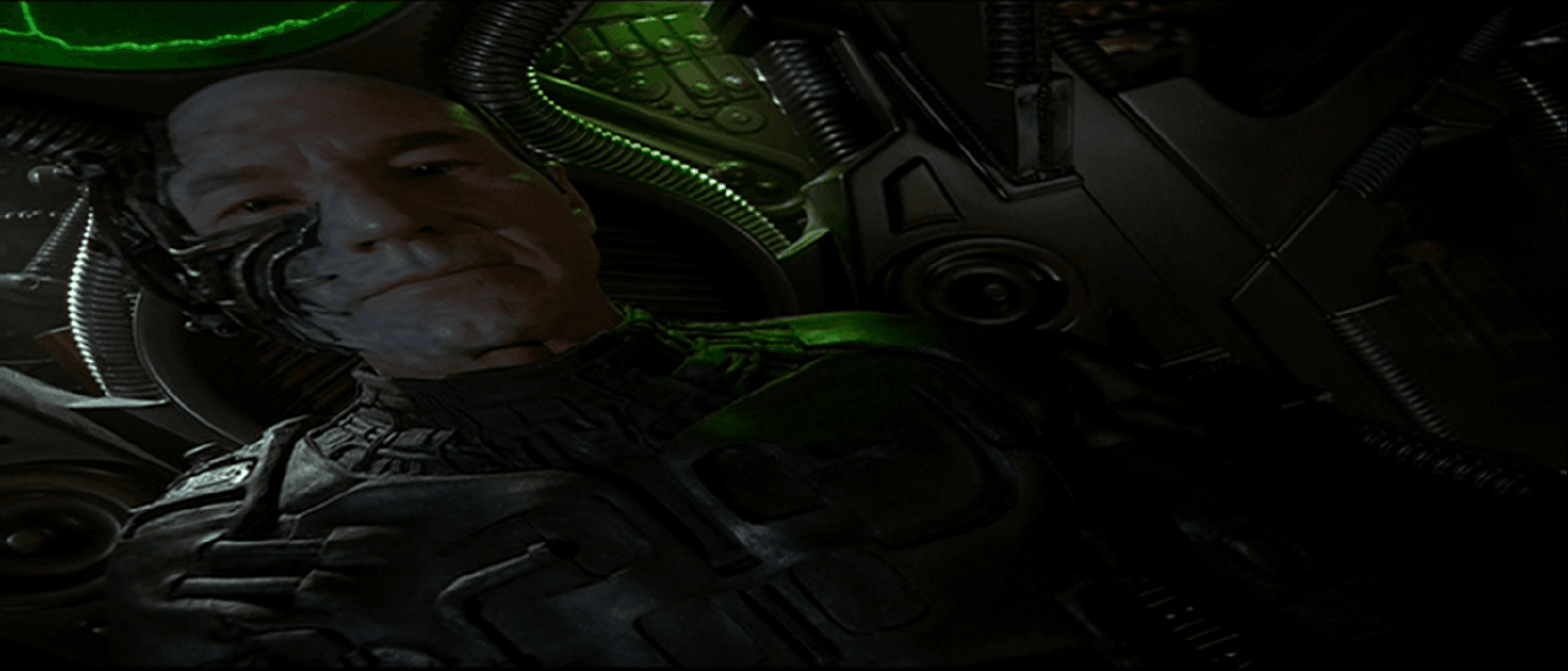
Welcome to the latest ‘Final Frontier Friday’! This week we’ll be doing something a bit different, as for the first time we’ll be taking a look at one of the movies, namely 1996’s ‘Star Trek: First Contact’.
So we’re finally doing a movie. But why now? Well, some of you may have already figured it out (And good for you!), but humor me, okay? To pull back the curtain a bit, I originally conceived, pitched, and embarked upon this column as “every two weeks, I’ll review a random ‘Star Trek’ episode.” And that’s what I’ve been doing for the last two and a half years. But in that time, I’ve definitely taken some liberties with the definition of “random.” And by that, I mean that I’ve stretched it in both directions, with there have being times when I haven’t figured out which episode I’ll cover until the Thursday before it’s due and others where I’ve known months in advance. This isn’t exactly the latter, but it definitely leans more toward that end of the spectrum. You see, this column is running on April 5th. First Contact Day. Once I realized that, I knew there was no possible way I’d be covering anything else this week.
 In reference to that other mega-popular sci-fi property, George Lucas has famously (or infamously, depending on who you talk to) described his two ‘Star Wars’ trilogies as “rhyming.” Lucas was referring to the on-screen narratives of his films, how plot points in one trilogy are often echoed or inverted in the other. But film series can rhyme off camera as well. And there was certainly a bit of that going on with the ‘Star Trek’ films in the mid-nineties. Though the original crew had been put out to pasture a few years earlier in ‘Star Trek VI: The Undiscovered Country’, big screen ‘Trek’ was given something it’s televised counterpart never quite had: a formal passing of the torch from one generation to the next. This would also present and opportunity for the crossover we’d all been waiting for, as Kirk and Picard came face to face. In 1994, this was about as big a deal as you could possibly have asked from a ‘Star Trek’ movie.
In reference to that other mega-popular sci-fi property, George Lucas has famously (or infamously, depending on who you talk to) described his two ‘Star Wars’ trilogies as “rhyming.” Lucas was referring to the on-screen narratives of his films, how plot points in one trilogy are often echoed or inverted in the other. But film series can rhyme off camera as well. And there was certainly a bit of that going on with the ‘Star Trek’ films in the mid-nineties. Though the original crew had been put out to pasture a few years earlier in ‘Star Trek VI: The Undiscovered Country’, big screen ‘Trek’ was given something it’s televised counterpart never quite had: a formal passing of the torch from one generation to the next. This would also present and opportunity for the crossover we’d all been waiting for, as Kirk and Picard came face to face. In 1994, this was about as big a deal as you could possibly have asked from a ‘Star Trek’ movie.
But as much obvious potential as the ‘Generations’ had, the results were decidedly mixed. The film was a financial success, opening at number one and remaining in the top ten at the box office until its fifth week of release. However, while I won’t get too deep into it here (that’s for another piece), the fact that ‘Generations’ was developed and produced in tandem with the final season of ‘TNG’ ultimately proved detrimental to both the season and the movie. While neither is bad (though a good friend of mine did once spend a summer using ‘Generations’ as an insomnia cure, so…), it’s hard to escape the sense that both could have reached greater heights had the cast, crew, and producers been able to give each project the attention it deserved.
But I digress. Mixed as they may have been, the results were good enough that a sequel to ‘Generations’ was greenlit within three months of the film’s release. And while the ‘Star Trek’ team may not have had to prove themselves to Paramount the way their predecessors had after ‘The Motion Picture’, there is an inescapable (albeit unspoken) sense that they made a point of stepping up their game for this outing. But how to go about that? Well, from first principles Rick Berman was of the opinion that the new film should reflect the sort of ‘Star Trek’ stories that had most resonated with him, namely time travel stories like ‘Yesterday’s Enterprise’ or ‘City on the Edge of Forever‘. On the other hand, Ronald D. Moore and Brannon Braga (who had been tapped to write the film) had their hearts set on bringing back the Borg, reasoning that not only had they not been seen in full force since ‘The Best of Both Worlds’ two-parter some five years prior, but they also provided the perfect villains for the scale of a feature film.
 The solution, as it turned out, was to dip Berman’s chocolate into Moore and Braga’s peanut butter, as the three quickly hit on the idea of the Borg travelling through time to assimilate humanity before it could present much of a threat (let alone effectively resist) the Collective. But once you’ve settled on doing a period piece, the question then becomes “Which period?” Among those considered were the Italian Renaissance and the American Civil War. Ultimately, though, they settled on the future. This came out of Braga’s desire to address the “birth of ‘Star Trek’.” But what did that mean, exactly? Well, sometime between now and the twenty-third century, humanity invents warp drive and begins meeting enough aliens to form a vast interstellar coalition. One of those logically leads to the other, and what better event is there to target if your goal is to prevent the Federation from existing? From there, it’s a short leap to Zefram Cochrane’s (established in the original series episode ‘Metamorphosis’ as the inventor of warp drive) test flight serving as the impetus for First Contact. And while it hadn’t yet been explicitly established onscreen, is there a more logical choice for humanity’s first contact than the Vulcans? I think we both know the answer to that.
The solution, as it turned out, was to dip Berman’s chocolate into Moore and Braga’s peanut butter, as the three quickly hit on the idea of the Borg travelling through time to assimilate humanity before it could present much of a threat (let alone effectively resist) the Collective. But once you’ve settled on doing a period piece, the question then becomes “Which period?” Among those considered were the Italian Renaissance and the American Civil War. Ultimately, though, they settled on the future. This came out of Braga’s desire to address the “birth of ‘Star Trek’.” But what did that mean, exactly? Well, sometime between now and the twenty-third century, humanity invents warp drive and begins meeting enough aliens to form a vast interstellar coalition. One of those logically leads to the other, and what better event is there to target if your goal is to prevent the Federation from existing? From there, it’s a short leap to Zefram Cochrane’s (established in the original series episode ‘Metamorphosis’ as the inventor of warp drive) test flight serving as the impetus for First Contact. And while it hadn’t yet been explicitly established onscreen, is there a more logical choice for humanity’s first contact than the Vulcans? I think we both know the answer to that.
